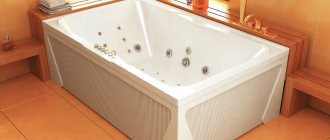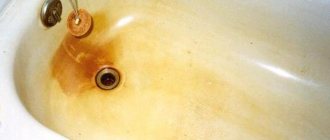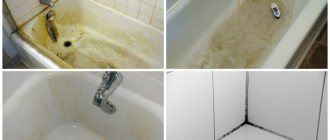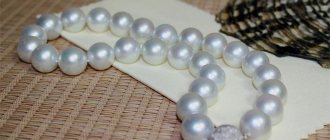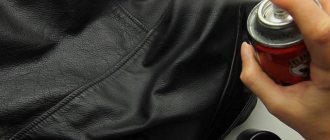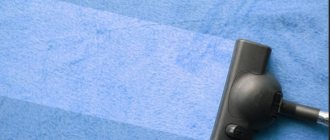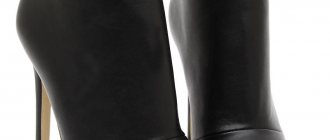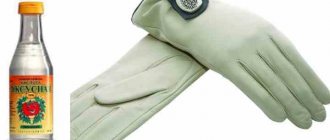Cleaning an acrylic bathtub is quite a serious undertaking. It must be approached responsibly. It is important to know that not every remedy is equally suitable for this.
Acrylic bathtubs always look beautiful and that is why they are so popular. They are lightweight and come in many different shapes and sizes, so they are suitable for any bathtub. This is an excellent alternative to replace cast iron containers.
Those who use acrylic bathtubs often do not know how to properly care for them. In reality, this issue requires a careful approach, because not every means can be used to clean such plumbing fixtures, otherwise it can simply be ruined.
What is good about acrylic: advantages
Acrylic bathtubs
Often owners of acrylic bathtubs are interested in how to clean them properly, because such plumbing fixtures are capricious and do not tolerate careless handling. In fact, caring for acrylic is very easy, unlike other materials.
The ease of cleaning can be explained by several properties of the polymer:
- Little porosity . Acrylic has extremely small pores, if any, and therefore dirt is not absorbed, but remains on the surface. So, you can simply clean your plumbing fixtures every day with a cloth and soap and it will never lose its appearance.
- Smoothness . Due to the fact that acrylic is smooth, harmful organisms cannot penetrate the material. So no abrasives are required to clean the surface.
- By the way, manufacturers often talk about the self-cleaning effect . This does not mean that the surface cleans itself. Simply due to the smoothness, dirt is repelled. So you have to clean it less often. Most often, cleaning can be done with plain water and soap.
What are the types of stains on acrylic bathtubs?
Types of contamination
Since polymers have become very popular not so long ago, the question of cleaning acrylic bathtubs at home has become very relevant. Acrylic products are excellent at repelling dirt, but with intensive use they leave a mark that makes the appearance worse and also makes cleaning more difficult. As a rule, you can find the following types of pollution:
- Yellowness . Over time, acrylic does not turn yellow, but this does not mean that this does not happen. To eliminate such contamination, you need to rinse the bowl using special products and install water filters, because the problem is precisely that the water is very dirty.
- Limescale . This defect can be observed when water with a high content of metal salts is used. Citric acid is ideal for eliminating it.
- Colored spots . Multi-colored stains can appear on the bathroom due to different dyes. The surface of the bathroom is quite smooth and this prevents the pigment from being too absorbed, and therefore any product will cope with such stains.
To prevent large contamination from appearing on your plumbing fixtures, make it a rule to care for them regularly. So try to always wipe the bathtub dry after washing.
Traditional methods
Toothpaste
When answering the question of what product can be used to wash an acrylic bathtub, it is worth first noting the possibility of using toothpaste for this purpose. Initially, acrylic was actively used in dentistry. With its help, crowns were made, and dentures were veneered. This is why toothpaste is ideal for cleaning your bathtub.
toothpaste without abrasive
Please note: before using toothpaste for this purpose, first make sure that it does not contain abrasives. To do this, you need to squeeze a little paste onto your fingers and rub it: the presence of small grains of sand indicates that the paste is abrasive.
To clean the bathtub, apply the paste to a sponge and thoroughly rub the dirty areas, then rinse the surface with water and rub it until shiny.
Vinegar
Vinegar is often used when cleaning acrylic surfaces, as it helps fight rust and limescale. The bath should be filled with water, after which you need to add 700 ml of 9% vinegar. The solution in the bowl can be left overnight, after which the liquid should be drained, and the surface of the bath should be washed with water and wiped dry.
Soda is a substance that perfectly copes with stubborn stains on various surfaces, helps fight limescale, and whitens perfectly. Many people are concerned about the question: is it possible to wash an acrylic bathtub with soda? There are 2 safe ways to clean an acrylic bathtub with soda:
- A pack of soda is poured into the bath, warm water is added and left for 1 hour. Then the solution is drained and the bath is wiped dry. The method is effective only if the problem is minor.
- Difficult to remove plaque must be removed with soda, which is diluted with water to a paste-like state. This paste is applied to problem areas and left for half an hour, after which it is washed off with water and wiped dry.
Lemon acid
Helps cope well with limescale deposits. To use this method, 200 g of citric acid is dissolved in warm water. The bath is filled with water and 1 liter of the prepared solution is added, left for a while (no more than 12 hours), after which the liquid must be drained and the surface of the bath wiped dry.
What products should not be used to clean an acrylic bathtub?
What should you not wash an acrylic bathtub with?
Please note that an acrylic bathtub cannot be cleaned using any means. If you don’t want it to lose its appearance, then remember that you absolutely cannot use:
- Bleaching . Do not try to clean the surface with a product containing chlorine. Instead of a beautiful surface, you will end up with a dull color that will ruin your plumbing. If you carry out the treatment again, small pores will begin to form, where dirt will always get in.
- Washing powder and abrasives . The abrasive scratches the surface and is destructive for acrylic. After treatment, scratches and damage may appear, which, of course, can be hidden by polishing and grouting, but the curved appearance of the bathtub makes this process difficult.
- Ammonia . If you use ammonia solutions, the acrylic surface will gradually deteriorate and lose its glossy shine.
- Acetone, gasoline and thinner . All these products are strictly prohibited for acrylic surfaces. It becomes cloudy and loses its attractiveness. If you use solvent regularly, you risk damaging the surface.
- Formaldehyde . Today, as a rule, formaldehyde is not used in household chores, but it is still important to know that they are not compatible with acrylic.
How to wash and how to clean an acrylic bathtub at home
Store-bought cleaning products
In this case, it is very important to prevent the material from aging; accordingly, you need to select products that have a mild effect and do not contain aggressive chemicals. As for specific measures, it is quite possible to get rid of shallow dirt using the same methods that are used when washing dishes. This means that a soft sponge and detergent can be used.
As already mentioned, the coating of such a bathtub is very sensitive to sharp objects, so hard sponges, brushes, and metal meshes should be abandoned. During cleaning, the working surface must be moistened, this is due to the same softness of the coating. The bathtub can become critically damaged even after the product comes into contact with ordinary powder.
As a preventative measure, it will be useful to wash the bathtub with soap and water after using the bathtub for its intended purpose. For the best effect, you can not dilute the soap, but immediately pour liquid soap onto the problem area and hold it for several minutes, then rinse everything off.
If you need to find a purchased product, then when looking for an answer to the question of how to clean an acrylic bathtub, you can immediately call “Tim-Profi”, which is notable for the fact that it can be used even on a neglected surface, moreover, the product can rid the room of an unpleasant odor, which may come from the bathtub.
A nice thing is that “Tim-Profi” creates a protective coating that prevents the appearance of yellow plaque in the future.
A very common product is Acrilan, which can also be used in a shower stall, if, of course, one is available. Akrilan solves all common problems. We are talking about getting rid of mold or rust. When using this product, a protective coating is also formed. It is prohibited to mix other products with Acrylan.
The category of common household chemicals includes Bass and CIF. Despite the fact that Bass is a liquid product, while CIF has a dry composition, they are not much different in terms of effectiveness.
If financial possibilities are limited and you need to find a cheaper product, then it is recommended to pay attention to the Mister Clean detergent, which is good at removing grease deposits and fungus.
How to properly care for an acrylic bathtub: rules
How to clean an acrylic bathtub?
- If you do not wash the bath on time, this will inevitably lead to the formation of severe dirt. To avoid this, try to wipe the bathtub with a sponge and soap after each wash.
- By the way, if you rinse the bathtub with hot water, it will shine even more. Most importantly, forget about hard brushes and sponges, otherwise you will damage the bathtub.
- Before applying any of the products, try spreading a little of it in an inconspicuous place and wait a little. If no changes are visible, then you can safely begin cleaning. Pay close attention to the disinfection process, because without it, harmful microbes begin to form in the pipes.
- Do not forget that chlorinated solutions are prohibited for use. Chlorine may also be present in special products, but only additional elements carefully reduce its impact.
- If you want your bathroom enamel to shine, rub the acrylic in a circular motion with a soft cloth. Pre-moisten it with a polish with a wax base.
How often should you clean an acrylic bathtub?
It is recommended to wipe down the acrylic bathtub after each use. We recommend following this rule, because it is easier to remove small dirt than stubborn dirt. This can be done with soap and a soft sponge, and after rinsing, wipe dry with a cloth.
As for the use of active substances, use them once every couple of weeks. Apply the product over the entire surface, leave for a short time, and then rinse well.
To prevent the formation of yellow discoloration, monitor the condition of your plumbing fixtures. If faucets start to leak, repair them as quickly as possible. If it turns out that the bathtub has turned yellow, then you can remove it with special means.
What products can be used to clean an acrylic bathtub?
Cleaning products for acrylic bathtubs
Acrylic is one of the subtypes of plastic and has excellent performance characteristics. Like steel bathtubs, the material cannot rust or peel, and it is also resistant to even the dirtiest water.
However, household chemicals are not acceptable for polymers, and third-party products should never be used. How then to remove pollution? Here you need to choose substances that will not react with acrylic. These include citric acid and vinegar.
But first you need to make a solution out of them, and not use them as is.
- Vinegar solution . To make a simple but good solution, fill the bathtub two-thirds full with water and add 9% vinegar. For cleansing you will need 0.5 liters. Mix everything well and leave it for 12 hours.
- Lemon acid . The same cooking algorithm is used, but just keep in mind that the granules may not dissolve and settle on the bottom. They will not give any reaction and will lie there. To avoid this, dilute the powder first and only then add it.
Today you can find good products on store shelves. They are effective in combating rust or limescale. Let's talk about them.
Cleaning an acrylic bathtub
Soap and dishwashing detergent are considered the most gentle of all. You can clean the bathroom with shampoo or shower gel. If you run out of one of the products, then just rinse the bottle and wash the walls of the bathroom with it. Such products will not harm the top layer and act gently.
If your bath has lost color and turned yellow, then you won’t be able to get by with simple soap. To do this you need to use polishing agents.
You should not use powders such as Pemolux, Biolan or Comet. First of all, they contain abrasives, and they also need to be rubbed in. So it is better to use liquid products or pastes. They will not damage the surface. You just need to work with them with gloves, since the composition is often aggressive.
If you decide to use such products, then the best among them are Bass, Cif and Acrilan. The latter is specifically designed for acrylic bathtubs.
How to clean an acrylic bathtub?
Is it possible to clean an acrylic bathtub with Sanox and Pemolux? Although the surface of this product is incredibly durable, it can also be damaged. Therefore, there should not be any sharp objects near it that could cause damage. But if you have already encountered such a problem, then you need to wash the bathtub using a soft cloth or sponge, using a good product with a liquid or cream-like consistency.
The following may be suitable for cleaning such a bath:
- Hair and body gels;
- Dishwashing detergents;
- Pre-foamed washing powder.
Important! This means all products that do not have a harmful effect on human skin. It will be very effective to use them immediately after washing in the bathroom. You simply soap the entire surface of the bowl, rinse off the foam with warm water and rub it with a sponge until it shines.
But there are also cleaning products for acrylic bathtubs that are specifically designed for this. They have a sign on the packaging indicating this. These are all liquids containing chemicals, due to which the product is washed much faster.
Is it possible to clean an acrylic bathtub with Domestos?
Domestos
Yes, undoubtedly, it is quite possible to use Domestos, but it has its own nuances and a competent approach to this matter will provide excellent results. The product contains hydrochloric acid, and it copes very well with limescale and rust.
It will easily remove all dirt from the bathroom without harming the surface. This is a modern cleaning product that has become popular due to its effectiveness. Specifically, it has the following advantages:
- High reliability and safety
- Low cost
- Removing plaque and dirt
- Gentle treatment of the surface
Domestos can be considered gentle and at the same time disinfecting. Due to its safety, it can be used to clean surfaces, but it is better to do this with gloves.
Detergent overview
Specialized cleaning products are available for bathtubs with acrylic coating. They help to quickly get rid of rust, plaque and wash the liner after swimming with colored foams.
Good reviews about the spray and gel from RAVAK Cleaner. These are products that are manufactured by a well-known manufacturer of acrylic bathtubs. It contains mild cleaning components that work well on the most common stains. In particular, Ravak will help wash rust from the bottom of the bathtub, remove grease and soap residues from the walls and restore shine and whiteness to acrylic.
Ravak for hot tubs
Bass is another well-known acrylic bathtub cleaner. This product comes in the form of a gel, unlike Ravak, it cleanses not only of dirt, but also of germs. It contains weakly concentrated acids. The product is applied to problem areas of the bath, distributed evenly over them, and then washed off with water. To remove it, you need to wipe the liner with the hard side of the sponge.
Cif acrylic bath cream has a pleasant smell and cleans plastic well of soap residues. But it will not help with pronounced yellowness or rust. It is considered more of a preventative than an active cleanser.
Cif Strength Cream for acrylic bathtub
The most common cleaners include Domestos and Sanox. In general, these funds are suitable, but we will tell you more about each below.
Is it possible to clean an acrylic bathtub with Sanox?
Sanox
This product is more affordable than Domestos and has similar properties. However, it also whitens surfaces well, which makes its use more widespread. The rules of use are almost the same as for Domestos.
After application, it must be left for some time for the effect to be effective. Today Sanox comes in several types:
- Spray
- Gel
- Foam
Gel and foam should be applied to the entire surface, and the spray should be sprayed. It is advisable that the spraying be carried out 10 cm from the surface.
How to remove defects from an acrylic bathtub?
Acrylic coating is not only susceptible to dirt. Sometimes scratches and other defects may appear on it. In a way, acrylic is unique because it scratches easily, but at the same time, it is also easy to remove the damage.
To remove small damage up to 0.5 mm, use felt. It is great for polishing surfaces. If the scratches are deep, then they can only be removed with a special product - liquid acrylic.
You don't even have to contact a specialist. You can buy a repair kit, which includes a spatula and a tube of product. It is applied to the defect site and rubbed in with a spatula. When the product hardens, you can treat it with felt.
Liquid acrylic allows you to eliminate even a large hole made through. Cover the outside with tape and put acrylic into the cavity.
Some defects and stains are very strong, and therefore the use of any means will not help. In this case, only special inserts will help out. Also, do not forget that acrylic does not like very high temperatures. Boiling water won't harm him, but the ash from a cigarette can leave an imprint.
Step-by-step guide for proper cleaning
The acrylic bowl should first be doused with water. Then, taking a soft sponge with the applied product, thoroughly wipe the entire coating or in fragments (only contaminated areas).
Since the gel is concentrated, after a minute or two, thoroughly pour it with warm water.
Now you will need a microfiber cloth. It absorbs moisture perfectly. Polish the product until it shines. There is no need to show much effort.
If you don’t like the result, then the procedure should be repeated. After all, sometimes it’s even useful to treat a bath with Domestos several times. The main thing is not to leave it on the surface for a long time. To get rid of unpleasant odors and disinfect, pour the product into the drain.
Contraindications: do not expose the container to high temperatures; refuse cleaning with abrasives; remove all objects that may contribute to the formation of cracks and scratches.
How to prevent dirt and damage on an acrylic bathtub: preventive measures
Preventive measures
The most effective way to prevent serious contamination is to follow the manufacturer's recommendations. It’s better to use it wisely so you don’t have to worry about cleaning it later. There are only 4 simple rules that you need to follow and your plumbing fixtures will last a long time:
- Wipe the bathtub dry each time after use.
- Try not to use very hot water
- Rinse the bathtub with a sponge and soap after use
- Do not use disinfectants frequently. It is enough to do this a couple of times a week
Always remember that improper cleaning of the bathroom can ruin expensive plumbing fixtures. So think before you use any products.
Basic rules for caring for an acrylic bathtub
Video: How to properly wash an acrylic bathtub and how to care for it, Lifehack https://www.youtube.com/watch?v=RMSOC7KMRVA
If you wash your new acrylic bathtub correctly, it will remain snow-white for many years. Recommendations for caring for acrylic bathtubs:
- Despite the prevalence of available cleaning products, it is better to use special gels and foams. They provide complete cleansing and get rid of bacteria, whereas homemade products can simply rub the dirt deeper into the plastic;
- After washing the bathtub should be wiped dry. Ideally, treat with polish;
- Cleaning does not have to be daily. To treat the walls after taking a bath, just wipe them with a sponge and cool water. But once a week, acrylic should be thoroughly cleaned with products intended for this purpose.
